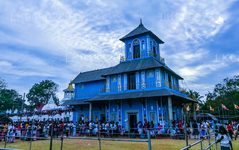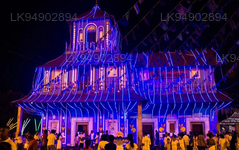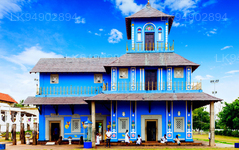
Kandy City
Kandy, en malerisk by i det centrale Sri Lanka, er kendt for sin rige kulturarv, livlige festivaler og smukke natur. Beliggende midt i frodige bakker, er den hjemsted for Tandtemplet, der er på UNESCOs verdensarvsliste, og byder på en betagende blanding af historie og naturlig pragt.
Maha Vishnu Devalaya
On to the North-West of the palace, in front of the “Natha Devale“ is the “Vishnu Devalya” popularly a the “Maha Devale”. This is one of the Hatara Devale in the Kandy, the other three being the Natha, Kataragama and Patini. These four Devalayas have a long association with the Royal Palace ( Maha Vasala) and the Temple of Tooth Relic (Sri Dalada Maligawa) and has been venerated by Buddhists and Hindus alike from the inception.
Different historical documents have called this deity and the Devale by different names. Robert Knox, the English Prisoner has called the deity in this devale “Aluth Nuwara Deiyo”. According to legend the “Aluth Nuwara Deviyo” was brought to Aluth Nuwara in Kegalle District from Devinuwara in Matara. This deity was called “Upulvan Deiyo” (deity with a colour of a lotus). Later this deity in Aluth Nuwara was known as “Vishnu”. The 15th century “Paravi Sandeshaya”, a poetical work describes the deity at Devinuwara, Matara as a destroyer of Asura. Thus it can believed that this same deity is also “Rama” of the great Indian Epic “Ramayana”. Interestingly “Ehelapola Varnanawa”, a poetical work done in the 19th century calls this shrine at Kandy, “The Rama Devale”. It is also interesting to note that this devale has had in possesion a cloth painting depicting the Battle of Rama and Rawana.
“According to Mahavansa, The great chronicle of Sri Lanka, It was “Upulvan Deiyo” thus Vishnu that was selected as the guardian to protect the land of Sri Lanka and Buddhism within it at the time of Buddha’s passing away.
“When the Guide of the World, having accomplished the salvation of the whole world and having reached the utmost stage of blissful rest, was lying on the bed of his nibbana; in the midst of the great assembly of gods, he, the great sage, the greatest of those who have speech, spoke to Sakka’ who stood there near him: `Vijaya, son of king Sihabahu, is come to Lanka from the country of Lala, together with seven hundred followers. In Lanka, O lord of gods, will my religion be established, therefore carefully protect him with his followers and Lanka.
When the lord of gods heard the words of the Buddha he from respect handed over the guardianship of Lanka to the god who is in colour like the lotus.
According to beliefs, Vishnu is a future Buddha after Natha. Therefore Vishnu always has had a high ranking within the deities worshipped by the Sri Lankans. During the Kandyan Era the the Kings “Abisheka Mangallaya” or the Coronation Ceremony was held at this Maha Devale.
The origin of Vishnu Devalya or the shrine of Vishnu is unclear. This is a long building with a storied sanctum at the end. In front the sanctum is a long hall called “dig-ge”. This hall is for dancers and who carry out puja for the deity. Today it is used by the devotees to pray. This building complex is entered through a two storeyed Vahalkada (entrance doorway), to an open hall with timber columns in the middle terrace, a beautifully carved stone flight of steps and the drumming hall. On the upper terrace is another small shrine, the God Dedimunda’s Shrine and a large Bo-tree.
Om Kandy-distriktet
Kandy-distriktet ligger i den centrale provins i Sri Lanka. Kandy er et af Sri Lankas syv verdensarvssteder og var engang hjemsted for Kandy-kongerne i det 16. århundrede og en kilde til al musik, kunst, håndværk og kultur i landet. Omkring 129 km fra Colombo ligger Kandy i et bakket terræn, og alles øjne drages mod byens centrum, hvor Kandy-søen danner et charmerende element. Kandy har fortsat stor religiøs betydning for Sri Lanka, fordi det er i denne charmerende by, at Dalada Maligawa eller "Tandtemplet" ligger, hvor Buddhas hellige tandrelikvie ligger velbevogtet.
Den Kongelige Botaniske Have i Peradeniya ligger omkring 5 km vest for bymidten i Peradeniya og besøges af 1,2 millioner mennesker om året. Det er den største botaniske have på øen. Udawatta Kele (Udawatta-skoven) er et beskyttet reservat beliggende i hjertet af byen, lige nord for Tandtemplet.
Kandy er en by med et flertal af singalesere; der er betydelige samfund, der tilhører andre etniske grupper, såsom maurere og tamiler. Kandy er kun overgået af Colombo, centrum for Sri Lankas økonomi. Mange store kooperativer har store filialer i Kandy, og mange industrier, herunder tekstiler, møbler, informationsteknologi og smykker, findes her. Mange landbrugsforskningscentre er placeret i byen.
Og et springvand for al musik, kunst, kunsthåndværk og kultur i landet. Omkring 129 km fra Colombo ligger Kandy i et bakket terræn, og alles øjne drages mod byens centrum, hvor Kandy-søen danner et charmerende træk. Kandy har fortsat stor religiøs betydning for Sri Lanka, fordi det er i denne charmerende by, at Dalada Maligawa eller Tandtemplet ligger, hvor Buddhas hellige tandrelikvie ligger velbevaret.
Om Centralprovinsen
Den centrale provins i Sri Lanka består primært af bjergrigt terræn. Provinsen har et areal på 5.674 km² og en befolkning på 2.421.148. Nogle større byer inkluderer Kandy, Gampola (24.730), Nuwara Eliya og Bandarawela. Befolkningen er en blanding af singalesere, tamiler og maurere.
Både bjerghovedstaden Kandy og byen Nuwara Eliya ligger i Centralprovinsen, såvel som Sri Pada. Provinsen producerer en stor del af den berømte Ceylon-te, som blev plantet af briterne i 1860'erne, efter at en ødelæggende sygdom havde dræbt alle kaffeplantagerne i provinsen. Centralprovinsen tiltrækker mange turister med bjergbyer som Kandy, Gampola, Hatton og Nuwara Eliya. Tempeltand eller Dalada maligawa er det vigtigste hellige sted i Centrel-provinsen.
Klimaet er køligt, og mange områder omkring 1500 meter har ofte kølige nætter. De vestlige skråninger er meget våde, nogle steder med næsten 7000 mm regn om året. De østlige skråninger er dele af den midterste tørre zone, da den kun modtager regn fra den nordøstlige monsun. Temperaturerne varierer fra 24°C i Kandy til kun 16°C i Nuwara Eliya, som ligger 1.889 m over havets overflade. De højeste bjerge i Sri Lanka ligger i Centralprovinsen. Terrænet er for det meste bjergrigt med dybe dale, der skærer sig ind i det. De to vigtigste bjergregioner er det centrale massiv og Knuckles-bjergkæden øst for Kandy.


























